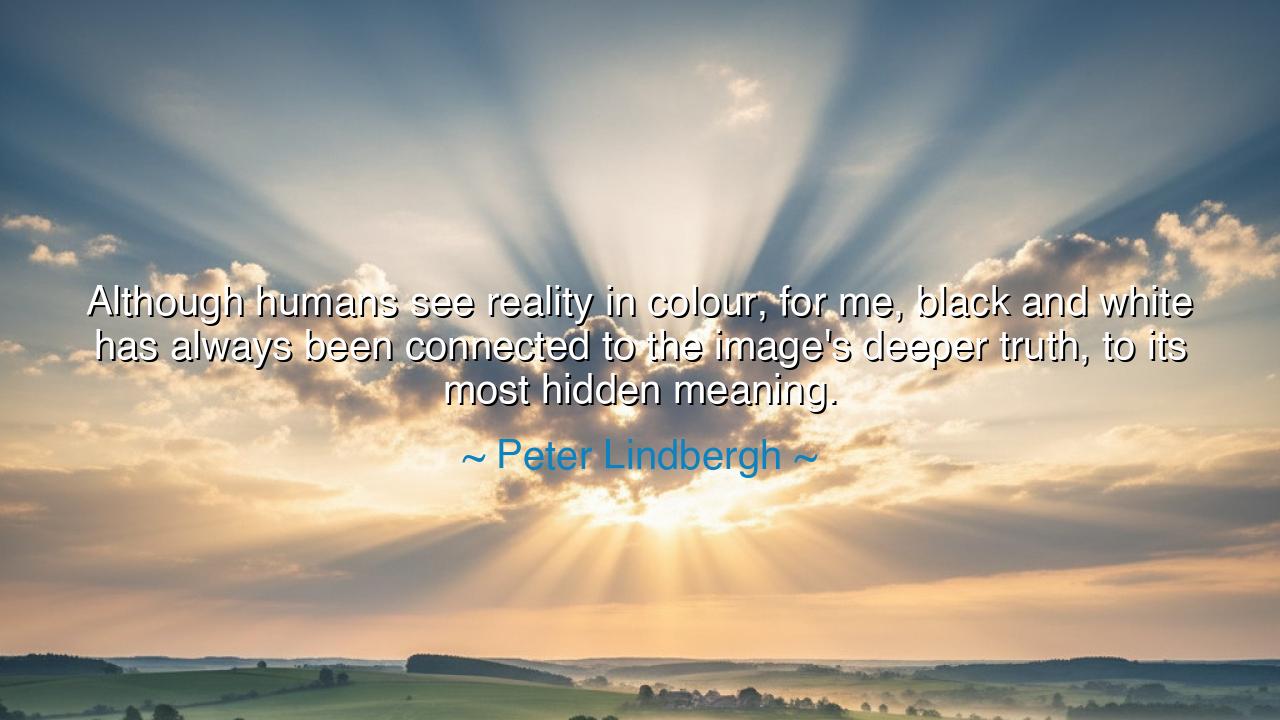
Although humans see reality in colour, for me, black and white
Although humans see reality in colour, for me, black and white has always been connected to the image's deeper truth, to its most hidden meaning.






The words of Peter Lindbergh—“Although humans see reality in colour, for me, black and white has always been connected to the image's deeper truth, to its most hidden meaning.”—speak like a hymn to simplicity, clarity, and essence. In them, the master photographer unveils a paradox: that though the eye delights in the brilliance of colour, the soul may perceive more deeply when the distractions of brightness are stripped away. For Lindbergh, the absence of colour is not a limitation but a revelation, a way of piercing through the surface of appearance to the marrow of truth itself.
The origin of these words lies in Lindbergh’s devotion to photography that went beyond fashion’s surface glamour. In an industry devoted to gloss, sparkle, and spectacle, he sought instead the raw, the authentic, the hidden meaning behind the mask. His portraits, often stark in black and white, laid bare the humanity of his subjects: the wrinkles, the glances, the quiet strength of a face unpainted. He believed that stripping away colour stripped away illusion, leaving only the form, the emotion, the soul. Thus he declared that truth dwelt most fully in the contrasts of light and shadow.
The ancients, too, knew the wisdom of reduction. The philosopher Heraclitus taught that opposites reveal the harmony of the world: day and night, life and death, joy and sorrow. In the same way, black and white photography embodies the eternal dance of contrast. Where colour dazzles the senses, black and white speaks to the heart in whispers of light and darkness, simplicity and depth. Lindbergh, like a sage, reminds us that to find what is hidden, one must sometimes look not at the abundance of details but at the bare essentials.
History offers parallels to this insight. Consider the work of the Renaissance sculptor Michelangelo, who said of his statues that he merely freed the form already hidden in the marble. The stone, stripped of excess, revealed the figure within. In the same way, Lindbergh used the absence of colour to chisel away distractions, revealing the essence of a person. What the world saw as limitation, he used as liberation, a path to the soul behind the eyes.
There is also a moral lesson hidden in these words. How often do we live in pursuit of colour—in noise, in spectacle, in outward adornment—forgetting that the heart of life is not in what dazzles but in what endures? To live always in the pursuit of glitter is to risk blindness to truth. But to embrace simplicity, to value the quiet contrasts of light and shadow, is to uncover meaning where the world least expects it. Lindbergh’s lens becomes not only a tool of art but a mirror for how to live: strip away what is unnecessary, and the hidden truth will stand.
Yet this is not a call to despise beauty, but to seek beauty beyond ornament. Black and white does not deny colour; it transcends it. In the same way, simplicity does not deny richness; it deepens it. The deeper truth, as Lindbergh reminds us, often lies not in what is added, but in what is taken away. To discern what is real, one must learn to see beyond the brightness, beyond the distractions, into the contrasts that define being itself.
Therefore, take these actions: in your work, in your relationships, in your inner life, dare to look beyond the dazzling surfaces. Learn to see with eyes that search for the hidden meaning behind appearances. Simplify, so that truth may emerge uncloaked. Practice stillness, so that what lies beneath the noise can be heard. And remember the wisdom of Lindbergh: though humans see reality in colour, it is often in the stark contrast of black and white that the deepest truths are revealed.






ITIn Tran
The idea that black and white can show a hidden meaning in a photograph is fascinating. I’m curious if this holds true for every kind of image or if certain subjects demand the vibrancy of color to express their full depth. Does Lindbergh believe that color photography can’t reveal these hidden truths, or is it just that black and white photography does so in a more focused, intense way?
TDThuy Dy
I can see what Lindbergh means about black and white images revealing deeper truths. There’s something about the simplicity of it that cuts to the essence of the subject. But I also question whether the absence of color sometimes oversimplifies a situation. Can black and white photos really capture all the nuances that a colored image would, or do they leave some context behind?
TNThao Nguyen
Lindbergh’s perspective on black and white photography as a window into deeper truth is thought-provoking. But I wonder if the meaning he finds in these images is universal or deeply personal. Do others see the same truth when looking at black-and-white photos, or is the meaning shaped by the viewer’s own experiences and biases?
YN21 Vo Yen Nhi
I love the idea that black and white photography reveals the hidden meaning of an image. There’s something timeless and raw about it. But I also wonder, does it always work? Are there moments where color is necessary to truly understand the complexity of a situation, or is the lack of color simply a way of emphasizing what we are supposed to notice?
TAVo thi thuy an
Lindbergh’s idea that black and white capture a deeper truth in an image is intriguing. It makes me wonder if removing the distractions of color allows us to focus more on the emotional core of a photograph. Does the absence of color force us to see things differently, or does it limit our interpretation by stripping away elements that are essential to understanding the full story?